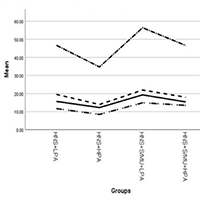Understanding the influence of high novelty-seeking on academic burnout: Moderating effect of physical activity

HTML: 33
All claims expressed in this article are solely those of the authors and do not necessarily represent those of their affiliated organizations, or those of the publisher, the editors and the reviewers. Any product that may be evaluated in this article or claim that may be made by its manufacturer is not guaranteed or endorsed by the publisher.
Authors
A large number of studies have shown a positive correlation between high novelty-seeking (HNS), substance/medication use (S/MU), high physical activity (HPA), and academic burnout (AB); however, the outcome of individuals with HNS in the terms of catching AB is doubtful. The present study was conducted to find out whether the personality traits such as HNS in medical students predisposes the AB or decreases its severity by increased physical activity (PA). This cross-sectional study, 227 medical students with HNS were selected from three major cities of Iran during February, 2019 to July, 2019 using convenience sampling and were assessed using demographic information form, Baecke’s physical activity questionnaire, and Breso’s academic burnout questionnaire. In this study, 126 male and 151 female participants were divided into four groups namely HNS + low physical activity (LPA) (n = 68); HNS + HPA (n = 73); HNS + S/MU + LPA (n = 72); and HNS + S/MU + HPA (n = 64). The study results indicated that the maximum and minimum mean scores of AB and its subscales were in the HNS + S/MU + LPA and HNS + HPA groups, respectively. In addition, the hierarchical multiple regression analysis results for the two groups of students with and without S/MU indicated that PA plays a moderating role in the relationship between AB and HNS. Given that the AB can be considered as an antecedent of depressive disorders, its lowered level could be effective in preventing major depressive disorder. Regarding the moderating role of PA in the relationship between HNS and AB, PA, as a relatively simple and inexpensive alternative to pharmacotherapy and psychotherapy, can be raised in the treatment and prevention of the AB.
How to Cite
PAGEPress has chosen to apply the Creative Commons Attribution NonCommercial 4.0 International License (CC BY-NC 4.0) to all manuscripts to be published.

 https://doi.org/10.4081/ejtm.2020.8722
https://doi.org/10.4081/ejtm.2020.8722



